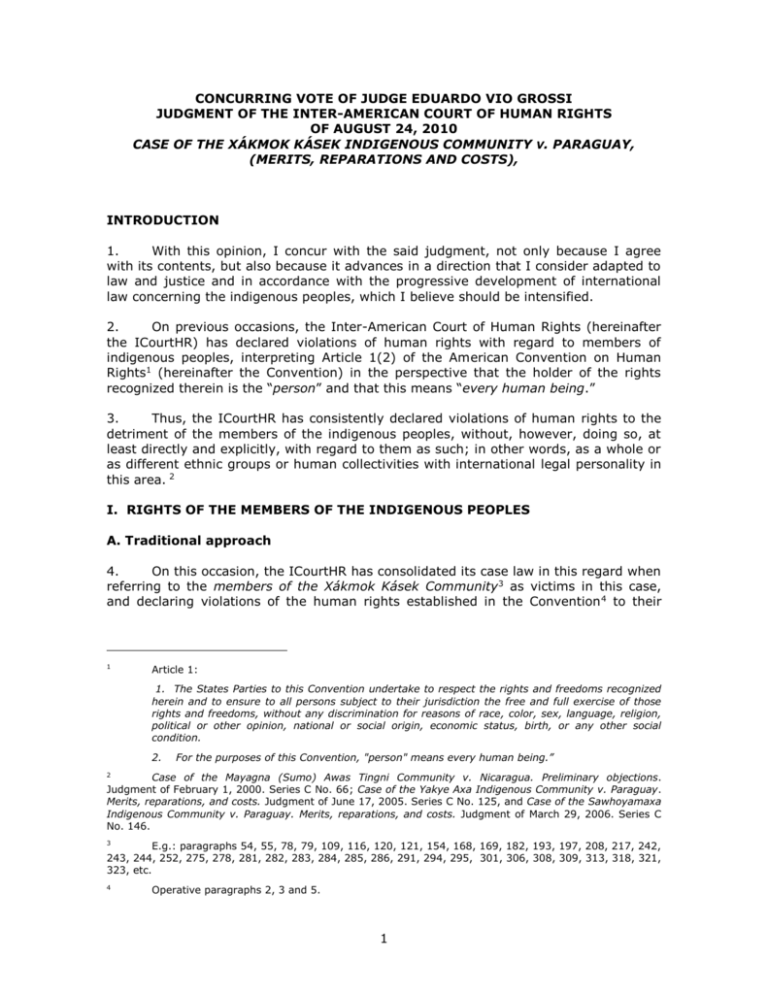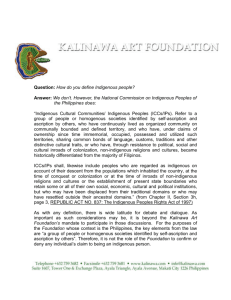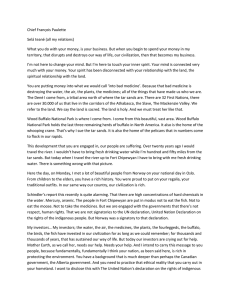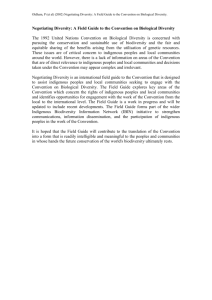CONCURRING VOTE OF JUDGE EDUARDO VIO GROSSI
advertisement

CONCURRING VOTE OF JUDGE EDUARDO VIO GROSSI JUDGMENT OF THE INTER-AMERICAN COURT OF HUMAN RIGHTS OF AUGUST 24, 2010 CASE OF THE XÁKMOK KÁSEK INDIGENOUS COMMUNITY V. PARAGUAY, (MERITS, REPARATIONS AND COSTS), INTRODUCTION 1. With this opinion, I concur with the said judgment, not only because I agree with its contents, but also because it advances in a direction that I consider adapted to law and justice and in accordance with the progressive development of international law concerning the indigenous peoples, which I believe should be intensified. 2. On previous occasions, the Inter-American Court of Human Rights (hereinafter the ICourtHR) has declared violations of human rights with regard to members of indigenous peoples, interpreting Article 1(2) of the American Convention on Human Rights1 (hereinafter the Convention) in the perspective that the holder of the rights recognized therein is the “person” and that this means “every human being.” 3. Thus, the ICourtHR has consistently declared violations of human rights to the detriment of the members of the indigenous peoples, without, however, doing so, at least directly and explicitly, with regard to them as such; in other words, as a whole or as different ethnic groups or human collectivities with international legal personality in this area. 2 I. RIGHTS OF THE MEMBERS OF THE INDIGENOUS PEOPLES A. Traditional approach 4. On this occasion, the ICourtHR has consolidated its case law in this regard when referring to the members of the Xákmok Kásek Community3 as victims in this case, and declaring violations of the human rights established in the Convention 4 to their 1 Article 1: 1. The States Parties to this Convention undertake to respect the rights and freedoms recognized herein and to ensure to all persons subject to their jurisdiction the free and full exercise of those rights and freedoms, without any discrimination for reasons of race, color, sex, language, religion, political or other opinion, national or social origin, economic status, birth, or any other social condition. 2. For the purposes of this Convention, "person" means every human being.” Case of the Mayagna (Sumo) Awas Tingni Community v. Nicaragua. Preliminary objections. Judgment of February 1, 2000. Series C No. 66; Case of the Yakye Axa Indigenous Community v. Paraguay. Merits, reparations, and costs. Judgment of June 17, 2005. Series C No. 125, and Case of the Sawhoyamaxa Indigenous Community v. Paraguay. Merits, reparations, and costs. Judgment of March 29, 2006. Series C No. 146. 2 E.g.: paragraphs 54, 55, 78, 79, 109, 116, 120, 121, 154, 168, 169, 182, 193, 197, 208, 217, 242, 243, 244, 252, 275, 278, 281, 282, 283, 284, 285, 286, 291, 294, 295, 301, 306, 308, 309, 313, 318, 321, 323, etc. 3 4 Operative paragraphs 2, 3 and 5. 1 detriment and, as a result, when ordering the return of the 10,700 hectares claimed 5 together with other measures in their favor.6 B. Inter-American legal doctrine7 5. This perspective seems to be shared by inter-American legal doctrine, as revealed by the 1997 draft American Declaration on the Rights of Indigenous Peoples, prepared by the Inter-American Commission on Human Rights,8 which indicates that: "Indigenous peoples have the collective rights that are essential for the enjoyment of the individual human rights of their members."9 6. In addition, the 1998 comments on this draft by the Inter-American Juridical Committee10 follow the same approach when indicating that: “International law in the field of human rights protects, with few exceptions, individual rights, while recognizing that, in certain cases, the exercise of individual rights can only be truly exercised collectively." II. RIGHTS OF INDIGENOUS PEOPLES A. Possible new perspective. 7. However, it is also true that the ICourtHR, in this same judgment, has referred to the Xákmok Kásek Community as the subject claiming rights, particularly with regard to the right to territory11 with the “communal ownership” that corresponds to it.12 In addition, it also expressly mentioned the Community, as the beneficiary of the measures ordered,13 even though, in some of those measures, it refers to the grounds for its decision where, to the contrary, it refers to the members of the collectivity, 14 and in others, it refers interchangeably, to them and to the Community. 15 5 Operative paragraph 12. Operative paragraphs 13, 15, 19, and 23, even though, in these operative paragraphs, the direct reference is made to “the Community”; however, when relating this to considering paragraphs 291, 294, 295 and 301, and operative paragraph 12, respectively, it should be understood that this reference is made indirectly to “the members of the Community.” 6 Even though, under this subtitle, reference is made to the decisions of two organs of an international organization, the OAS, so that it could be considered that they are expressions of the auxiliary source of international law, the so-called “Decisions of international organizations declaring legal rights,” they are, however, cataloged as legal doctrine, another auxiliary source of international law, considering that one is a proposed Declaration, which has not yet been adopted by the corresponding parties, and the other contains observations on the former and, in both cases, they are issued by advisory organs of the said international organization. 7 8 AG/RES.1479 (XXVII-O/97). 9 Article II(2). First phrase. 10 OEA/Ser.Q CJI/doc.29/98 rev.2 11 E.g.: paragraphs 64 et seq. and 80 et seq. 12 E.g.: paragraph 85 et seq. 13 Operative paragraphs 13 to 15, 23, 25, and 26. 14 See supra note 6 in relation to operative paragraphs 13, 15, and 23. 15 Operative paragraphs 25 and 26. 2 8. Thus, with these references, the ICourtHR, without departing from its traditional position, appears to leave open the possibility that, in the future, it could be able to take a new approach to the matter, particularly when it affirms, in paragraph 85 of this judgment, that it: “has considered that the close relationship of indigenous peoples with their traditional lands and the natural resources linked to their culture that are found there, as well as the intangible elements resulting from them, must be safeguarded by Article 21 of the American Convention.” 16 9. Similarly, in paragraph 86 of this judgment, the ICourtHR reproduces what it has stated on other occasions,17 that among the indigenous peoples: “There is a tradition in the communities with regard to a communal form of collective ownership of the land, in the sense that this does not belong to an individual, but rather to the group and its community. Because they exist, the indigenous peoples have the right to live freely on their own territories; the close relationships that the indigenous peoples maintain with the land must be recognized and understood as the essential basis of their culture, their spiritual life, their integrity, and their economic survival. For the indigenous communities, their relationship with the land is not merely a matter of possession and production, but rather a material and spiritual element that they must enjoy fully, even in order to preserve their cultural legacy and transmit it to future generations.” 10. And, in paragraph 87 of this judgment, the ICourtHR adds that: “Moreover, the Court has indicated that the concepts of property and possession in indigenous communities can have a collective meaning, in the sense that possession is “not focused on individuals, but on the group and its community.” This concept of the ownership and possession of land does not necessarily correspond to the classic concept of property, but it deserves equal protection under Article 21 of the Convention. Failing to recognize the specific versions of the right to use and enjoyment of property that emanate from the culture, uses, customs and beliefs of each people would be equivalent to maintaining that there is only one way of using and enjoying property and this, in turn, would make the protection granted by Article 21 of the Convention meaningless for millions of individuals.” B. The case of Paraguay. 11. To understand the effects of the recently drafted paragraphs and supporting the thesis that the ICourtHR appears to be envisioning an approach that departs from the classic position held in this area, it should be recalled that, in this case, both the InterAmerican Commission on Human Rights and the representatives of the victims repeatedly indicated that the rights they considered violated by Paraguay were the rights of both the Xákmok Kásek Community, and of its members, without the respondent State in this case, Paraguay (hereinafter the State), contesting the capacity of the Community as a collective subject of rights.18 16 Article 21. “Right to Property 1. Everyone has the right to the use and enjoyment of his property. The law may subordinate such use and enjoyment to the interest of society. 2. No one shall be deprived of his property except upon payment of just compensation, for reasons of public utility or social interest, and in the cases and according to the forms established by law. 3. Usury and any other form of exploitation of man by man shall be prohibited by law.” Cf. Case of the Mayagna (Sumo) Awas Tingni Community v. Nicaragua, supra note 2, para. 149; Case of the Sawhoyamaxa Indigenous Community v. Paraguay, supra note 2, para. 118, and Case of the Saramaka People. v. Suriname. Preliminary objections, merits, reparations and costs. Judgment of November 28, 2007. Series C No. 172, para. 90. 17 18 E.g.: Paragraph 2. 3 12. Similarly, and in the same regard, it is appropriate to add, in relation to the case in question, that the State had ratified, and by means of Law No. 234/93 19 had incorporated into its domestic law, Convention No. 169 of the International Labour Organization concerning Indigenous and Tribal Peoples in Independent Countries (1989), which, in its Article 3(1) states that: “Indigenous and tribal peoples shall enjoy full human rights and fundamental freedoms without hindrance or discrimination. The provisions of this Convention shall apply without discrimination to male and female members of these peoples.” 13. On the other hand, and in keeping with the above observations, it should also be noted that the Constitution of Paraguay establishes rights in favor of the indigenous communities as collectives,20 and that this State has an Indigenous Communities Statute that recognizes the juridical personality of the communities.21 14. On this basis, the ICourtHR indicated in the Yakye Axa case22 that: “Under Paraguayan legislation, the indigenous community has ceased to be a factual reality and become a full subject of rights, which are not restricted to the rights of its members as individuals, but rather are rooted in the community itself, endowed with its own singularity.” 15. It would seem clear then that, at least in the case of Paraguay, both international law and its domestic law recognize rights to the indigenous peoples as such, and not merely to their members. C. Progressive development of international law. 16. Thus, this situation is located in the same process of change that general international law is experiencing in this sphere and that coincides with the new perspective that the ICourtHR could apply in the future when examining this issue; 23 This is revealed, particularly, from the provisions of the said Convention No. 169 of the International Labour Organization concerning Indigenous and Tribal Peoples in Independent Countries (1989). a. Decisions of international organizations 17. This process of change is expressed, for example, in the 2007 United Nations Declaration on the Rights of Indigenous Peoples, Article 1 of which establishes that: “Indigenous peoples have the right to the full enjoyment, as a collective or as individuals, of all human rights and fundamental freedoms as recognized in the Charter of the United Nations, the Universal Declaration of Human Rights and international human rights law.” 19 Law No. 234/93 ratifying ILO Convention No. 169. 20 Constitution, articles 62 and 63. Law No. 904/81, Statute of the Indigenous Communities (f376 p1, merits; f378 p2); Law No. 1.372/88 (f376 p2 merits). 21 Case of the Yakye Axa Indigenous Community v. Paraguay. Merits, reparations and costs. Judgment of June 17, 2005. Series C No. 125, para. 83. 22 23 Article 31 of the Vienna Convention on the Law of Treatises. “General Rule of Interpretation. 1. A treaty shall be interpreted in good faith in accordance with the ordinary meaning to be given to the terms of the treaty in their context and in the light of its object and purpose. […] 3. There shall be taken into account, together with the context: […] c) any relevant rules of international law applicable in the relations between the parties.“ 4 18. The comment of the Committee on Economic, Social, and Cultural Rights of the United Nations regarding the right to benefit from the protection of the moral and material interests resulting from scientific, literary or artistic productions, also belongs to the indigenous peoples in their capacity as collective subjects, and not only to their members as individual subjects of rights.24 19. Subsequently and in this regard also, in its General Comment No. 21 of 2009, the said Committee interpreted that the term “everyone” contained in Article 15(1)(a) of the International Covenant on Economic, Social, and Cultural Rights:25 “May denote the individual or the collective; in other words, cultural rights may be exercised by a person (a) as an individual, (b) in association with others, or (c) within a community or group, as such.” 26 b. Inter-American legal doctrine 20. Even inter-American legal doctrine inclines towards this universal trend, as revealed by Article II(1) of the above-mentioned draft of the American Declaration on the Rights of Indigenous Peoples, when it stipulates that: “Indigenous peoples have the right to the full and effective enjoyment of the human rights and fundamental freedoms recognized in the Charter of the OAS, the American Declaration of the Rights and Duties of Man, the American Convention on Human Rights, and other international human rights law; and nothing in this Declaration shall be construed as in any way limiting or denying those rights or authorizing any action not in accordance with the instruments of international law including human rights law.” 21. This concept is reiterated in Article XVIII(2) of the draft, when it notes that: “Indigenous peoples have the right to the recognition of their property and ownership rights with respect to lands, territories and resources they have historically occupied, as well as to the use of those to which they have historically had access for their traditional activities and livelihood.” 22. In turn, the above-mentioned comments of the Inter-American Juridical Committee on the recently cited draft, indicate, in paragraph 3(6), that: “There is no doubt that the indigenous peoples and their members have the right to full and effective enjoyment of the human rights recognized universally, and the Declaration must reaffirm this […]” 24 General Comment 17, paras. 7, 8, and 32. 25 Article 15 “1. The States Parties to the present Covenant recognize the right of everyone: a) To take part in cultural life; b) To enjoy the benefits of scientific progress and its applications; c) To benefit from the protection of the moral and material interests resulting from any scientific, literary or artistic production of which he is the author. 2. The steps to be taken by the States Parties to the present Covenant to achieve the full realization of this right shall include those necessary for the conservation, the development and the diffusion of science and culture. 3. The States Parties to the present Covenant undertake to respect the freedom indispensable for scientific research and creative activity. 4. The States Parties to the present Covenant recognize the benefits to be derived from the encouragement and development of international contacts and co-operation in the scientific and cultural fields.” 26 General Comment 21, para. 9. 5 c. Other instruments 23. In addition, another international legal instrument, but this time of a regional nature, the 1986 African Charter on Human and People’s Rights, incorporates this tendency when it establishes the special protection of certain rights of the indigenous peoples based on their exercise as collective rights.27 III. THE SCOPE OF THE HUMAN RIGHTS OF THE INDIGENOUS PEOPLES AND THEIR MEMBERS. A. Specific rights 24. It could then be argued that the said international texts, autonomous sources of international law, such as the treaties, and auxiliary sources, such as the decisions of organs of international organizations, refer to the human rights of the indigenous peoples and even of their members when it is a matter of the specific rights of either these collectivities or their members, which are, consequently, distinct or different from those in force for all human beings. Otherwise, the special or distinctive declaration in some of the legal instruments mentioned (those which seek precisely to have legal effect, in other words, to establish or to determine the international legal obligations derived from the rights thus declared), would be meaningless and lack justification. A. Rights of the collectivity 25. All the foregoing allows for a broader understanding of the provisions of Article 1 of the Convention,28 so that the obligation to respect and ensure to all persons the exercise of the rights established in the Convention would also include the collectivities or communities, such as the indigenous peoples, to the extent that at least some of these rights extend to these entities. Rights that, consequently, the members may only enjoy and exercise through the collectivity and because they form part of it, which, all things considered, would imply that such rights are not merely of an individual nature. CONCLUSION 26. In other words, based on the above, and applying the provisions of Article 29(b) and 29(d) of the Convention,29 it can be concluded that, in keeping with the progressive development of international human rights law, it would be appropriate, on the one hand, to include in the term “person” contained in several articles of the Convention and as victims of violations of rights established in it, not only the African Charter on Human and Peoples Rights: Article 20, which protects the right to existence and self-determination; Article 21, which protects the right to the natural resources and ownership of their lands, and Article 22 which guarantees the right to development. 27 28 29 See note 1. Article 29: “No provision of this Convention shall be interpreted as: […] b. restricting the enjoyment or exercise of any right or freedom recognized by virtue of the laws of any State Party or by virtue of another convention to which one of the said states is a party; […] and, d. excluding or limiting the effect that the American Declaration of the Rights and Duties of Man and other international acts of the same nature may have.” 6 members of the indigenous peoples, considered individually, but also the indigenous peoples as such; and, on the other hand, consequently, to consider among these rights, those that concern these peoples, so that not only would justice be served, but, also, the case law would thus be situated, more clearly and without margin for error, in the modern trend that is emerging increasingly clearly in international law on this matter. Eduardo Vio Grossi Judge Pablo Saavedra Alessandri Secretary 7









